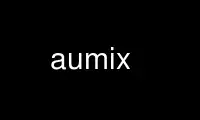
This is the command aumix that can be run in the OnWorks free hosting provider using one of our multiple free online workstations such as Ubuntu Online, Fedora Online, Windows online emulator or MAC OS online emulator
PROGRAM:
NAME
aumix — adjust audio mixer
SYNOPSIS
aumix [-<channel option>[[+|-][<amount>]]|<level>|R[ecord]|P[lay]|q[uery]] [-dhILqS] [-f <rc
file>][-C <color scheme file>]
DESCRIPTION
This program adjusts the settings of an audio mixing device. It can be used from the
command line, in scripts, or interactively with the keyboard or mouse.
OPTIONS
CHANNEL OPTIONS
-v main volume
-b bass
-c CD
-i input gain
-l line
-m microphone
-o output gain
-p PC speaker
-r record
-s synthesizer
-t treble
-w PCM
-W PCM 2
-x mix monitor
-1 line 1
-2 line 2
-3 line 3
For each channel, q queries, + and - increment and decrement by one, or an amount if one is
specified. If no + or - is given after the channel option, a number sets a specific level
(monophonically).
OTHER OPTIONS
-C color_scheme_file
specify the name of a file containing a color scheme. This implies -I. The
color scheme file may reside in the current working directory or in the aumix
data directory, typically /usr/share/aumix or /usr/share/aumix-gtk if you are
using the GTK-enabled aumix package. This option can be used to force the
ncurses interface with a GTK version. No need to specify a filename in that
case.
-d device_file
specify the name of the mixer device (default is /dev/mixer)
-f rc_file specify file for saving and loading settings
-h display information on usage
-I run aumix interactively, using the full-screen ncurses-based interface. This is
the default if no options are given, but must be specified in order to have
aumix go into interactive mode after doing things non-interactively.
To force use of the ncurses interface with the GTK version, specify -C (no need
to give a filename).
-L load settings from $HOME/.aumixrc, or /etc/aumixrc if the former is inaccessible
-q query all devices and print their settings
-S save settings to $HOME/.aumixrc
EXAMPLES
The command
aumix -q -v75 -m 0 -c R -c+10 -m q
prints all settings, sets volume to 75%, sets microphone to 0, sets CD to record, increases
the CD level by ten (both left and right), and prints the new settings for the microphone.
The .aumixrc file containing:
vol:60:60
wait:5000
vol:50:50
sets the volume to 60%, waits five seconds, then reduces the volume to 50%. Note that
"wait" lines will not be saved by aumix. They must be added by hand.
INTERACTIVE USE
If no options are given on the command line, and aumix is compiled with ncurses, it will run
interactively.
LAYOUT
The left bank of controls is used for adjusting levels; the right bank is for adjusting
balance. Mixing channels not supported by your hardware will not be shown. Mixing channels
which are stereo-capable will have balance controls.
KEYS
The following keys control aumix in interactive mode:
page up, page down, up and down cursor
select a new control.
Tab, Enter, <, >, comma and period
toggle between level and balance controls
+, -, [, ], left and right cursor and digits
adjust the setting of the current device. The + and right cursor keys increase
the level by 3%; the - and left cursor keys decrease it by the same amount. The
[ key sets it to 0% and ] or 0 set it to 100%. The digits 1 to 9 set it to 10%
through 90%. The digit 0 sets it to 100% (not 0%). The same keys work
analogously on the balance controls.
Space toggles between record and play for controls which are capable of this.
| centers the balance of the current device.
K or k show a description of the functions of keys
L or l load settings from $HOME/.aumixrc, falling back to /etc/aumixrc
M or m mute or unmute
O or o “only”: mute all channels but the current one
S or s save settings to the rc file
U or u undo any muting
Q or q end the program
^L refresh screen
^Z, ^D and ^C also have their normal function (the screen is refreshed when aumix is brought
to the foreground).
MOUSE
In interactive mode, aumix can accept input from the mouse if gpm(8) is running and aumix is
compiled with gpm(8) support. If gpm is not running but gpm support is included, the
message ‘mouse off’ will appear at the top of the screen, and only keyboard input will be
accepted. With gpm(8) running, most functions can be performed through the mouse. The
mouse is active whenever one of its buttons is held down. While active, it works in the
following ways:
· over a control track, it sets the control to match the position of the mouse cursor.
· over a record/play indicator, it toggles the record/play state.
· over the ‘Quit’, ‘Load’, ‘Save’, ‘Keys’, ‘Mute’, ‘Only’, or ‘Undo’ labels at the top of
the screen, it causes those actions to take place.
ENVIRONMENT
The HOME variable is used. When aumix is compiled with GTK+ support, DISPLAY is checked,
and if set is used. LANG is used when aumix the ncurses screen is displayed.
Use aumix online using onworks.net services
